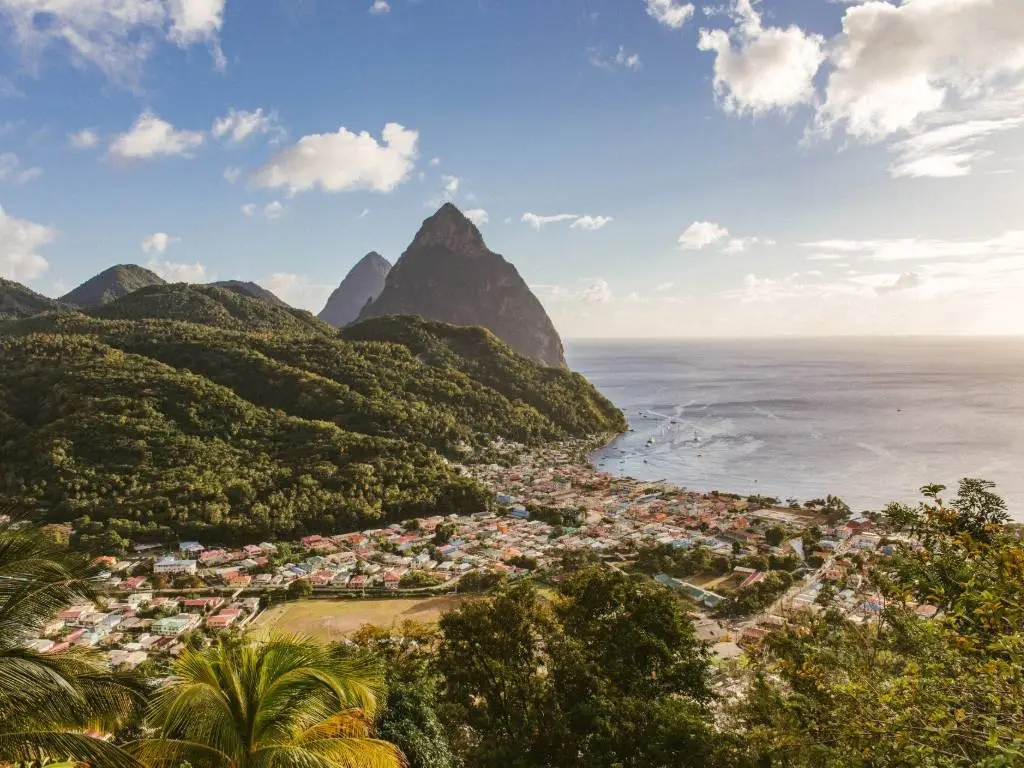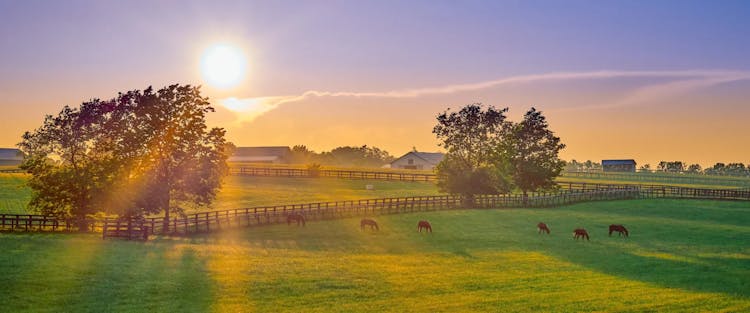
St. Lucia: The Caribbean Island With the World’s Only “Drive-in Volcano”
St. Lucia is proof that all islands are not created equal. Named after Saint Lucy of Syracuse, it’s the only country named after a female historical figure—but that’s not its only claim to fame.
The island’s natural, unspoiled beauty has helped St. Lucia earn the distinction of being awarded the World's Leading Honeymoon Destination a record 14 times by the World Travel Awards. There are beautiful sandy beaches, lively seaside towns, and the island's iconic twin peaks, the Pitons.
The island’s flavorful West Indian cuisine and joie de vivre collide every weekend in fishing villages like Gros Islet, Anse La Raye, and Dennery, where the freshly grilled catch is accompanied by intoxicating rhythms, dancing, and dominoes. The exuberant abandon of carnival revelry, incredible hiking, and magical waterfalls help make St. Lucia unforgettable.
Caught in a tropical tug of war
The first inhabitants of St. Lucia were the Arawak people who arrived from South America around 200 AD and called the island Louanalao, or Island of the Iguanas. That name would change to Hewanorra in 800 AD with the arrival of the Kalinago, or Caribs. Both groups brought customs and crops still used on the island. The Caribs remained in St. Lucia until the late 1500s as the Europeans fought to settle on the island.
Buccaneer François le Clerc, a.k.a. Jambe de Bois, was the first to arrive from France and claimed Pigeon Island at the island's northern tip because of its strategically elevated location. The Dutch followed, setting up camp on the southern end in Vieux Fort, but were chased away by the Caribs. An attempt at colonization by the British was also met with resistance from the Caribs, who defeated them in less than two years.
The French eventually purchased the land from the Caribs, which prompted the British to return for a battle between the two European countries that saw St. Lucia change ownership 14 times. The extensive fracas left St. Lucia with the moniker Helen of the West Indies, a nod to Helen of Troy, whose beauty sparked the Trojan War.
Pirates of the Caribbean

Jack Sparrow’s pillaging escapades took center stage in St. Lucia during filming for the first Pirates of the Caribbean movie, The Curse of the Black Pearl. The majestic twin Pitons made a cameo, as did the natural arch at Marigot Bay. The softwood schooner that appeared in the films as the Henrietta and later the Terrasaw was known to locals as the Brig Unicorn. The glossy sailing vessel had another star turn in the 70s as a slave ship in the TV series Roots. It was the boat of choice for romantic sunset cruises until it sank in 2014 during a trip to nearby St.Vincent and the Grenadines for repairs.
Piracy wasn’t just a Hollywood-manufactured fantasy in St. Lucia. French pirate François le Clerc and his crew used historic Pigeon Island as an outpost to attack Spanish treasure galleons. Waterside haunt Jambe de Bois is named after le Clerc’s wooden peg leg.
Learning to talk again
English is the official language of St. Lucia, but Creole (Kwéyòl) or Patois is widely spoken, particularly by the older population. The dialect is a holdover from when enslaved Africans were brought to the island between the 17th and 19th centuries to work in sugar production. As the English and French battled for control of St. Lucia, the enslaved people formed their own language to communicate with each other.
Unfortunately, with each generation, the use of the language dwindled and was relegated to conversations at home and sharing traditional stories. Kwéyòl’s slavery origins led to its mischaracterization as inferior and a dialect associated with low socioeconomic status and lack of education. But despite the negative stigma and social biases, there was a movement to preserve the language.
Educator Jones E. Mondesir published the first Dictionary of St. Lucian Creole in 1992. The Ministry of Education of St. Lucia followed suit with another version. The Folk Research Centre spearheaded workshops on creole development, Kwéyòl was featured in the Throne Speech, newscasts were delivered in the dialect, and consideration is being given to integrating Creole into the school curriculum.
October is recognized as Creole Heritage Month with events like Jounen Kwéyòl (Creole Day) to celebrate the language and traditions.
Feeling hot, hot, hot

St. Lucia’s volcanic origin is instantly recognizable in the famed Pitons. The mountainous peaks are two volcanic plugs from an eruption thousands of years prior. Gros Piton, the larger of the two, and Petit Piton were awarded UNESCO World Heritage status in 2004. Both are popular with hikers, but the shorter trail up Petit Piton is more arduous and the panoramic views at the top make the journey worthwhile. Even though the Pitons appear attached, Gros Piton is located in Soufrière, while Petit Piton is in Choiseul.
Close by is another remnant of volcanic activity. The Sulphur Springs is a collapsed crater billed as the world’s only drive-in volcano. The last volcanic eruption in the area was recorded in 1776, but it is still in the most active geothermal spot in the Lesser Antilles. The pungent smell, often likened to rotten eggs, might be a turnoff but is quickly overshadowed by the soothing hot springs and pools and mud baths believed to hold healing powers and detoxifying properties.
St. Lucia’s favorite sons
St. Lucians take immense pride in holding the record for the most Nobel laureates per capita, according to the Guinness Book of World Records, with two winners. Sir William Arthur Lewis was the first, winning the Nobel Prize in Economics in 1979.
He shared the honor with Theodore Schultz, for their groundbreaking economic development research, with a specific focus on the problems of developing countries. You can trace the economic growth of countries like Hong Kong, Singapore, Taiwan, and South Korea to the dual-sector model, commonly known as the Lewis Model. Among his many accomplishments, Lewis was also the first Black professor in Britain’s university system and later at an Ivy League university. The island’s community college bears his name.
Another son of the soil, Sir Derek Walcott, won the Nobel Prize in Literature in 1992. The poet and playwright garnered a slew of literary awards throughout his storied career for his work that focused on themes of colonialism, Caribbean culture, history, and language. Among his many accolades are an Obie award for his play Dream on Monkey Mountain, a MacArthur Foundation fellowship, the Queen's Medal for Poetry, and the 2011 T. S. Eliot Prize for his book of poetry, White Egrets. He received the Nobel Prize shortly after publishing Omeros, an epic poem spread across seven books of 64 chapters each and widely considered his magnum opus. The public square and park located in the city are named after him.
Both men are celebrated annually on Nobel Laureate Day, which falls on their shared birthday, January 23rd.
Birds of paradise

Ornithophiles are partial to St. Lucia’s avian life. There are 191 species of birds on the island, five of which are endemic. The colorful and vibrant Amazona versicolor, also known as the Jacquot, is only found in St. Lucia and is the island’s national bird.
The St. Lucian parrot was once among the rarest birds in the world due partly to natural disasters and illegal trade until the Forestry Division of the Ministry of Agriculture launched an effort to save the species from extinction in 1978. Other endemic species include the St. Lucia black finch, St. Lucia oriole, St. Lucia pewee, and St. Lucia warbler.
The 1.75-mile Millet Bird Sanctuary Trail is a popular birding location where you can catch a glimpse of the endemic species in addition to over 30 others, including the Grey Trembler, Pearly-eyed Thrasher, Lesser Antillean Flycatcher, Mangrove Cuckoo, and Caribbean Elaenia.
Cuckoo for cocoa
St. Lucia’s cocoa production dates back to the 1700s when the island exported its cacao beans to parts of Europe and Hershey, Pennsylvania, to create rich, premium chocolate. Today, cocoa plantations like Anse Chastanet Resort’s Emerald Farm, and Fond Doux Eco Resort allow visitors to witness the chocolate-making process, from visits to the cacao seedling nursery to the traditional cocoa-rina dance used to polish the beans.
The month of August has been designated Chocolate Heritage Month and features a host of cocoa-themed activities, classes, beauty treatments, and tours. For a truly immersive experience, micro-batch producer Cacoa Sainte Lucie allows guests to take a hands-on approach to creating gourmet chocolate in the tiny village of Canaries.
One of the most beloved drinks on the island is St. Lucia’s version of hot chocolate—cocoa tea. This is a decadent, chocolatey breakfast beverage made from grated natural, pure cocoa with sugar, nutmeg, cinnamon, star anise, and other aromatic spices. It is a staple part of a traditional creole breakfast and sometimes includes dumplings for a heartier meal.
Please don’t stop the music

Calypso, soca, and dancehall are the musical genres typically associated with West Indian islands. But in the early 2000s, a new wave started taking root in the small fishing community of Dennery on St. Lucia’s east coast.
Village resident Jahim Etienne, a.k.a. Dub Master J of Studio 911, is considered one of the originators of the new sound, which became known as Dennery Segment. The music uses the drum influences of the traditional folk music known as solo and infuses it with the local Kwéyòl dialect. The mainstream largely rejected it, but one of Etienne’s tracks “Kwiyé 911” would gain traction in neighboring French territory Martinique. Angolan Kuduro music also gained popularity on the island in the mid-2000s, adding another layer to the Dennery Segment lore.
St. Lucian producer Lashley “Motto” Winter took Dennery Segment to the masses by pairing the local rhythms (known as riddims) with major soca artists like Machel Montano. It has found success in parts of the US, Europe, and Asia. But the songs, which are typically performed in a mix of English and Kwéyòl, continue to be uniquely Lucian thanks to local artists including Subance and Mighty, who are responsible for the ubiquitous “Bad in Bum Bum” and Freezy, whose “Split in di Middle” was a global sensation. Dennery Segment is now a staple at Carnival celebrations and fêtes islandwide.
Something seems fishy
St. Lucia’s fishing industry has developed considerably over the years from small and seasonal to more commercial, with a few fisheries complexes open for business seaside. A typical catch includes dolphin (dorado), tuna, red snapper, carangue, kingfish, and marlin. But residents don’t always need to venture to the water’s edge for their seafood needs. Fishermen and their assistants often load up the cab of pickup trucks with heaps of ice and fish, traveling around communities providing door-to-door service. The fish is weighed, scaled, and even cleaned before being placed in the basins and plastic bags of the buyers.
Despite the abundance of fresh fish, saltfish (also known as codfish or bacalao in some cultures) features heavily in the island’s cuisine. It is one half of the national dish, greenfig and saltfish. The meaty fish is salt-cured and dried but soaked overnight to remove excess salt before preparation. After a subsequent boiling, the saltfish is pulled apart into flakes then sauteed with oil, onions, garlic, tomatoes, and sometimes curry. Saltfish is also mixed into a seasoned flour-based batter and fried to produce accras or fishcakes. These are typically served with fried or roasted bakes and cucumber salad for a traditional local breakfast.
There are four fishing villages along the northern, western, and eastern coasts, three of which host weekly seaside celebrations. The Gros Islet Street Party and Anse La Raye Fish Fry Fridays and the Saturday Night Fish Fry in Dennery are staples on the local social calendar. It’s a quintessential St. Lucian “lime”—local parlance for a hangout—featuring seafood, barbeque, cold drinks, and good music.
Read about the cheapest Caribbean vacations and join Going to get alerts when cheap flights to the St. Lucia (and around the world) pop up.
More Caribbean destinations:
Published November 17, 2023
Last updated December 19, 2023
Articles you might like
View AllTreat your travel to cheap flights
Most deals are 40-90% off normal prices with great itineraries from the best airlines. If it's not an amazing deal, we won't send it. Sign up for free to start getting flight alerts.




